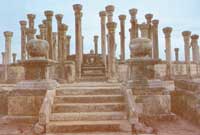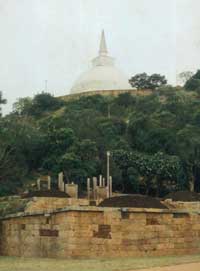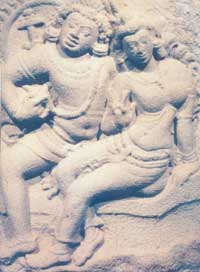|
Gaveshaka
continues the narration on early Buddhist art
The Kantaka
Chaitya in Mihintale is a fine example of a small dagoba. It features
some of the finest stone carvings and terra cotta figures. They
are well preserved to this day. The presence of a ‘vahalkada’
or frontpiece is another interesting feature in this chaitya. It can be observed that after the 4th century, the building of colossal dagobas has virtually ended. Thereafter smaller ones have been built using Thuparama in Anuradhapura as a model. This type came to be known as ‘vatadage’ or rotunda. It is a circular relic house and apart from Thuparama and Lankarama in Anuradhapura, the best example is seen in Polonnaruwa.
There are two other beautiful ones at Medirigiriya close to Polonnaruwa and Tiriyayi off the Anuradhapura-Trincomalee road. These circular shrines enclosed stupas of smaller size and had wooden pillars right round. Later they were replaced by carved stone pillars. The pillars are arranged in four to two concentric circles, diminishing in size outwards. After the sacred Tooth Relic of the Buddha was brought to Sri Lanka in the ninth year of the reign of King Kitsirimevan (303-331 BC), a temple to keep the Tooth relic was built in Anuradhapura from where the king ruled. Thereafter in each capital of the Sinhalese kings, there was a separate Temple of the Tooth. The earliest Buddha images found in Sri Lanka are of the standing type and they resemble those found in Amaravati in India. Our Buddha images have been done out of limestone and are said to be much more impressive than those in India. Images and sculpture show the influence of the Gupta period in India. The famous Isurumuniya lovers is a fine example of this influence. Along with the other piece of sculpture showing the man and the horse, they are two of the most beautiful and most famous carvings of ancient Sri Lanka. Isurumuniya also boasts of a number of elephants carved out of stone. Incidentally, Isurumuniya is the first rock temple mentioned in our history. It is mentioned that 500 wealthy persons who had been ordained came for relaxation to this rock. On account of their being ‘isurumat’ (wealthy), the place was called Isurumuni.
The Great Brazen Palace or Lova Maha Paya shows how the kings (in this case King Dutugemunu) built excellent monastaries for the use of monks. It was a quadrangular palace being one hundred cubits in length and the same in height. There were nine storeys, each of them having one hundred apartments. A special hall was erected in the centre of the palace and it was supported on golden pillars. While the kings built stupas and monasteries for the monks to reside, the royal palaces were also marvels of Sinhalese architecture. The palace complex was within the inner city and it was protected by high ramparts. History records that the palace of King Parakramabahu the Great had one thousand rooms. Royal baths formed a special architectural feature of the early times. Some of the remains of these show that each bath in Anuradhapura was 20 feet 10 inches square. The inner walls were paved with dressed stone. An underground drain 70 feet long supplied water from Tissawewa. In Polonnaruwa, the royal baths (‘kumara pokuna’) were located within the palace. There were stone slabs in three tiers. The lotus bath was paved with stone slabs resembling the petals of an open lotus. Royal pleasure gardens in Anuradhapura are also fine examples of ancient architecture. |
||||
Copyright © 2001 Wijeya Newspapers
Ltd. All rights reserved. |


